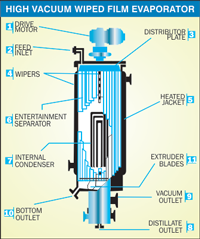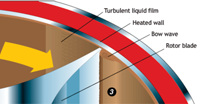Services
Semmathi Engineering is a market leader in Grease Plant Equipment Suppliers, Industrial & Automobile Lubricating Oil Blending Plant. Lube Oil Plant and Grease plants equipment offered by us are designed and tailor made to suit all International and local conditions & customer requirements.
Our range of lube and grease plant equipments range made suit for simple manually operated plants to highly sophisticated and fully automated plants.
We offer these services with various package based on customer requirements.
Our film evaporators are mainly used in the following industries :
Industries and Products
Chemical and fine chemical industry
Pharmaceutical industry
Food and beverage industry
Biotech industry
Oleochemical industry
Nutraceutical industry
High Vaccum Wiped Film Evaporator
Feed material enters through inlet , passes onto the distributor plate, then through four evenly spaced weirs onto the internal heated wall. Rotating slotted wipers spread the feed material into a uniform thin film and continuously move even highly viscous materials down the heated wall. Vaporized material passes through the entrainment separator and condenses on the internal U bundle condenser. Distillate flows out the distillate outlet and non-condensables flow out through the vapor outlet. The bottom, or residue, continues collector and flows out the residue outlet. Droplets of liquid caught by the entrainment separator flow down and off the separator into the residue collector. Extruder blades , mounted on the bottom of the rotor assembly, mechanically push the residue to the residue outlet.
How Thin Film Evoporates Work
An inherently simple device, the LCI agitated thin film evaporator (also commonly referred to as a “wiped film evaporator”) consists of two major assemblies: a heated body and a rotor.
Product enters (1) above the heated zone and is evenly distributed over the unit’s inner surface by the rotor. As the product spirals (2) down the wall, bow waves (3 in illustration above) developed by the rotor blades generate highly turbulent flow, resulting in optimum heat flux and mass transfer.
Volatile components are rapidly evaporated. Vapors flow either counter-currently (4) or co-currently (5) through the unit, depending on the application. In both cases, vapors are ready for condensing or subsequent processing.
Nonvolatile components are discharged at the outlet (6). Continuous washing by the bow waves minimizes fouling of the thermal wall where the product or residue is concentrated most.
The combination of 1) extremely short residence time, 2) narrow residence time distribution, 3) high turbulence, and 4) rapid surface renewal permits the LCI thin film evaporator to successfully handle heat-sensitive, viscous and fouling-type fluids.





